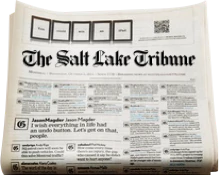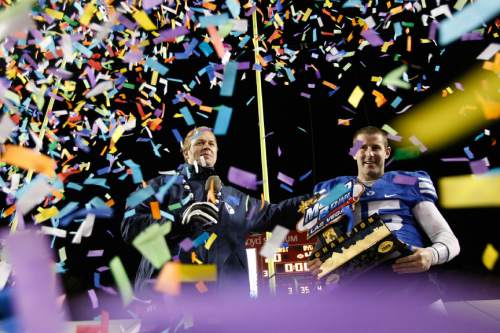This is an archived article that was published on sltrib.com in 2015, and information in the article may be outdated. It is provided only for personal research purposes and may not be reprinted.
Las Vegas • Clad head-to-toe in BYU gear, Draper's Brandon Christensen strolled through the Hard Rock Hotel & Casino on Wednesday morning hoping to get a glimpse of a BYU player or coach, perhaps grab an autograph or two for his 14- and 10-year-old sons following closely behind.
A few feet to Christensen's left, alcohol flowed at one of several casino bars, all while the usual assortment of slot machines, craps tables and roulette wheels lured other patrons seeking other types of jackpots. Not long after BYU players and coaches arrived Tuesday night, Christensen said with a laugh, several "scantily clad women" gyrated to rock-and-roll music atop one of the bars visible from the hotel lobby.
Do you have a problem with this?
"No, not at all," said Christensen, who, like most BYU fans, is a member of The Church of Jesus Christ of Latter-day Saints, which forbids alcohol and frowns upon gambling, two of the elements that have earned Las Vegas the moniker "Sin City." for all who visit the place, not just Mormons.
Christensen isn't alone. Hundreds of BYU fans are staying at the Hard Rock this week — the casino having been designated as the host hotel for BYU.
It has transformed itself into the "ultimate Cougar headquarters" with BYU-themed menus and performances by the Provo-based rock band, The Moth & The Flame, yet still provides most of the other "entertainment" for which Vegas is known.
Utah's designated hotel is the Mandalay Bay on the famed Las Vegas Strip, but several Ute fans could be seen at the Hard Rock on Wednesday afternoon, with at least one noting it was slightly less expensive than Mandalay Bay and they didn't realize when they made their reservations they would be surrounded by BYU fans.
"We love coming here," said Christensen, who attended all five of BYU's previous appearances in the Las Vegas Bowl, from 2005-2009. "You just try to ignore some of this other stuff and don't take yourself too seriously. It's Vegas, after all."
This year's Las Vegas Bowl — pitting rivals Utah and BYU for the first time in a bowl game — will be played at 1:30 p.m. on Saturday at 40,000-seat Sam Boyd Stadium on the outskirts of town, and was sold out within 24 hours of the matchup being announced.
The Utes played here last year, walloping Colorado State 45-10, while BYU returns for the first time since 2009 after having crushed Oregon State 44-20 in senior quarterback Max Hall's final game. All five of those games were sellouts, beginning in 2005, and Las Vegas Bowl executive director John Saccenti said BYU's presence "laid the groundwork" for what it is now, a bowl televised nationally by ABC that kicks off the entire bowl season.
"It is true — absence makes the heart grow fonder," Saccenti said of BYU's return this year. "We had BYU for five consecutive years, and we were all ready for a little bit of a break at that point, but we have missed you guys. BYU will always hold a special place in our heart."
Certainly, most BYU fans — but not all — and Las Vegas make strange bedfellows, Saccenti acknowledged. But the arrangement somehow works, for a variety of reasons.
First, it is an easy drive for most Wasatch Front fans, and second, there are a lot of BYU fans living in Las Vegas. The area is home to more than 140,000 Mormons, and the third-largest branch of the Cougar Club outside of Utah. It is an easy drive for the thousands of BYU fans who live in Southern California, as well.
Asked which fans will have more fun in Las Vegas this week, BYU safety Kai Nacua, a Las Vegas native, gave the nod to Utah fans.
"They will do their thing," he said with a shrug. "Saturday, we will see who has more fun, yeah."
Legendary BYU coach LaVell Edwards fueled the notion that BYU fans travel to bowl games in droves but don't spend money when he noted that BYU fans bring a copy of the Ten Commandments and a $50 bill and break neither. Coach Bronco Mendenhall referred to that well-worn line last week, to which Saccenti replied: "He said that, not me."
Amanda Arentsen, communications manager for the Las Vegas Convention and Visitors Authority, said it is impossible to gauge how much each fanbase spends, or what it spends money on, but noted that Utah fans spent plenty last year. Of the 33,475 fans who attended the game, 26,800 were from out of town and the total economic impact was an estimated $26.3 million. Figures weren't available from BYU's visits 6-10 years ago.
Saccenti said the belief that a visit from BYU creates less of an economic impact than other schools is mostly myth.
"Whenever you bring 11, 15, maybe 20,000 fans … to town, there is no way that is not going to be some sort of economic impact," he said. "The key number we look at, and what is most important for our game, is the non-gaming economic impact. If the fans are staging at a hotel, and staying at the team hotel, and spending nights in room, that is kind of the most important thing for us. The gaming numbers, we hardly ever see those. We hardly ever focus on those. … I expect we will be relatively close to what we were the last few years, in terms of economic impact."
Whatever the case, Saccenti said BYU fans took the bowl from a good game with decent local support to an event the entire community looks forward to.
"That first year that we announced BYU, that game sold out, and it completely changed the perception of the game, and it kind of elevated us to another level," he said. "What it did is really put the game on the map nationally. … The game has come a long way, and we do owe a lot of what BYU did that first year, against Cal."
When BYU comes to town, Saccenti concluded, business is good.
"Everybody wins," he said.
And for Las Vegas, that might be the most unusual happening of all.
Twitter: @drewjay —
2014 Las Vegas Bowl details
Matchup • Utah vs. Colorado State
Total attendance • 33,475
Out-of-town visitors • 26,800
Direct visitor spending • $15.9 million
Total impact • $26.3 million
Source: Las Vegas Convention and Visitors Authority



